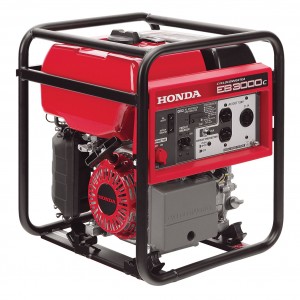 The name “Honda” is synonymous with quality, especially when it comes to generators. However, even the best made generator can be unreliable or even dangerous if not used correctly. Here’s what you shouldn’t do with your generator, whether you have a small portable model, a home backup system, or a portable power source for work sites.
The name “Honda” is synonymous with quality, especially when it comes to generators. However, even the best made generator can be unreliable or even dangerous if not used correctly. Here’s what you shouldn’t do with your generator, whether you have a small portable model, a home backup system, or a portable power source for work sites.
1. Use It Indoors
It may seem convenient to put your generator in a place where the outlets are within easy reach, but doing so can be lethal. When internal combustion engines burn fuel, they create carbon monoxide. This odorless gas latches onto your red blood cells, preventing them from carrying the oxygen your body needs to function. According to the Consumer Product Safety Commission, generators are the cause of 85% of carbon monoxide poisoning deaths outside of fires. Make sure your generator sits outside, away from buildings, and use extension cords to get the power to where you need it.
2. Get the Wrong Size
Overloading your generator can wear it out prematurely, so it pays to get a unit big enough to meet your power needs. There are plenty of calculators available online to estimate your needs. One thing to keep in mind is that you won’t necessarily need enough power to run everything at once. Some devices with electric motors need extra power to turn on, but you can plan around this, turning off a few things to handle the load spike so you can reduce your total power requirements.
If you have an unusual appliance and have no idea how much power it draws, test it with a plug power meter. This device plugs in between the outlet and the power cord, showing you real time power draw so you’ll now exactly how many watts it draws.
3. Wire It Up Yourself
Using your generator as a backup for grid power? Then it needs to be installed by a licensed electrician. A transfer switch needs to be installed to keep the generator from feeding power back into the grid which can cause a fire and potentially electrocute anyone working on the power lines. The generator also need to be installed in a way that meets all local safety codes. An improper installation isn’t just unsafe, it will void your home and fire insurance.
4. Use Bad Extension Cords
Getting extension cords is probably not on the top of your list when the power goes out, but using old, thin cords can cause a serious strain on your generator and your appliances with an added dash of fire danger. Before you actually need them, buy some higher gauge cords that can transfer electricity from your generator to the devices you plan on using.
5. Use Old Fuel
Modern gasoline ages quickly, which can make your generator harder to start and keep it from producing full power. Untreated gas shouldn’t be kept for more than 30 days, while gas treated with a stabilizer shouldn’t be used after 90 days. Have fuel that’s a little past its prime? Pour it into your car’s gas tank where it can be diluted with fresh fuel, then buy some new gas for your generator.
6. Have Too Little Fuel
Honda generators are designed to automatically adjust the throttle according to power demand to save fuel, but high demand can burn through gas far faster than the quoted maximum run time. When in doubt, make sure you have enough fuel to sustain your use at the quoted maximum fuel consumption level.
7. Forget the Maintenance
Most models have an hour meter to help you keep track of how much the generator has been used, but some maintenance tasks need to be performed at regular intervals, even if the engine was never started. Oil ages as it sits, and corrosion can build up on battery terminals reducing the power that reaches the starter motor.
What’s the best place to get parts for your Honda generator? www.hondalawnparts.com. We’re a certified Honda small engine equipment dealer, carrying everything you need for your generator from circuit breakers to engine components, and we can ship whatever you need across the U.S. and Canada.
